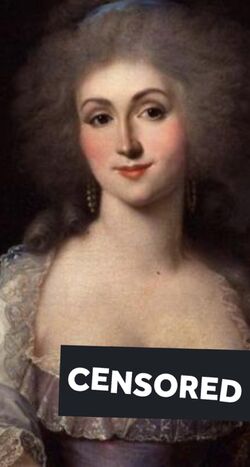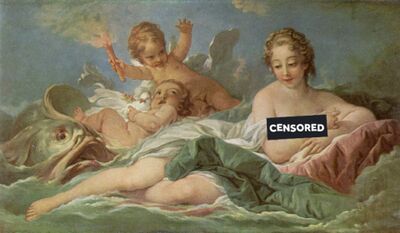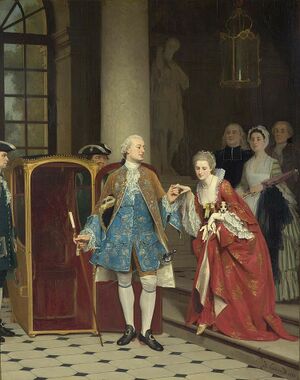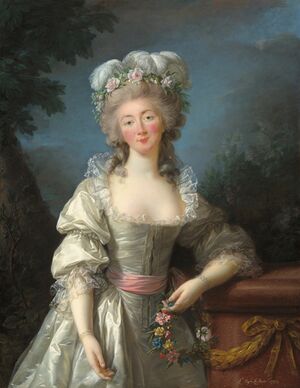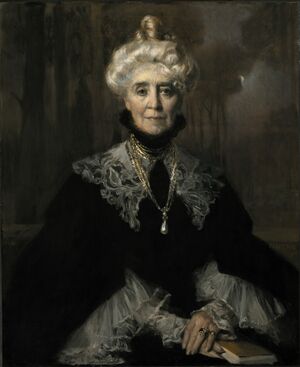Madame Rothesay
|
|
Madame Rothesay (5th of the Sun’s Smile, ca. late 1740s/early 1750s - present), named Renée Antoinette Rothesay at birth, was the official mistress of Emperor Peter III of Oren from 1765 until his death in 1784.
She was the second ever public mistress of an Orenian emperor, her predecessor being the bawdy Maude of Copper Court. Oddly enough, Renée’s ancestress was the sorrowful empress of the aforementioned Maude’s lover, Arielle Rothesay of Leone, and it is cited by aplenty that Renée frequently jested that she was “Arielle’s Revenge”.
Many historians are led to believe that Renée, in an attempt to distance herself from her lowborn precursor, put forth great efforts in convincing Peter to give unto her the honorary title of Maîtresse-en-titre, an Auvergnian term which literally translates as “official mistress”. Prior to this occurrence, there are multiple reports of primary lovers of Aeldinic monarchs using the aforesaid style as the way to formally address them, even in non-Auvergnian speaking courts, most likely due to it’s complex, ceremonious pronunciation that hardly alludes to it’s true taboo meaning. Thus, shortly after the birth of her first child, Renée was invested as Oren’s first Maîtresse-en-titre, and she set about legitimizing her courtly role beyond simply being the sovereign’s concubine.
Contents
Biography
Childhood
Renée Antoinette Rothesay was the daughter of Duke Anton of Leone and the infamous Princess Olympe-Athénaïs, a Madame Royale of Banardia. Oddly enough for her relatively high birth, a birth certificate has never been uncovered for the Leonian, which has baffled historians for centuries as to what year exactly Renée was born in. It certainly does not help that she, more often than not, refused to disclose her full birth date on a multitude of official documents, and, when she rarely did, the year provided was never consistent with any date she had given before or after. It is asserted by many scholars that this was most definitely not an honest mistake, and instead it was a way in which the vain Renée attempted to evade old age and it’s decaying effects on one’s beauty.
However, it is known that she was most definitely born during or after 1746, since that is the year when her mother, Olympe-Athénaïs, purchased the Château de Vaussèche, a cold, somber castle on the Banardian-Gaekrinese border in which Renée putatively spent her formative years. Although the niece of a Banardian king, she was afforded nary a luxury and had a seemingly grim, poverty-stricken upbringing. It can be said with full confidence that Renée’s dreary juvenile days were solely due to her mother’s heretical beliefs; Princess Olympe was among one of the first Aeldinic royals to publicly support a short-lived, and largely disorganized religious movement that denounced the papacy.
Due to her mother’s blackened reputation, her hand in marriage was considered soiled, regardless of her blood’s proximity to that of the king’s. Out of pity, a former close friend of her mother’s, Renée of Angoulême, invited the girl to her husband’s ducal court at Limoges. Though, after she was presented, and subsequently publicly rejected by the Limogian heir, Césaire-Régis, on account of her “inadequate height (she was 4’11) and overly plump figure”, there was considerable pressure on her to return to her mother’s holdings. She outright refused, and went on to befriend the notorious souteneur, Grégoire-Séraphin du Bourgonnière. Their fateful meeting occurred just a few days after Grégoire had lost his most profitable employee to the merciless, foul grip of a venereal disease. Needless to say, the man was desperate to find a replacement posthaste. Usher in the youthful, buxom Renée who was as naive and mannered as they come.
Life as Mademoiselle de Varambon
The partners in crime somehow landed in Banardia’s royal court at Lucinière, just in time for when society there was at its apex, the start of summer. Grégoire then bribed an old friend to have Renée introduced to the king, where she was passed off as “Mademoiselle Antoinette-Aurélie de Varambon, niece to Baronet du Bourgonnière”. It is reported that the youth made an amazing impression on the king and his court, especially after her gown fell off mid-curtsy, revealing her voluptuous figure for all to see. The stunt garnered the reaction Renée and Grégoire had hoped for, the room broke out into a masculine frenzy, though, to the shock of everyone present, the painfully awkward Grand Dauphin rushed down from the dais, hastily placed the dress back onto the girl, and rushed her out of the throne room. Immediately after that, false rumors of an illicit relationship between the Dauphin and the sultry mademoiselle began to vigorously swirl about the palace, which in turn afforded her instantaneous popularity and a slew of admirers. One of them being the Dauphin’s own father, King Louis the Handsome. Grégoire made quick work of arranging bookings for the Rothesay, and it is said in his recovered ledgers that Varambon had raised more money in a week than his last “niece” did in a month. For the first year, the two were riding unbelievably high: they had more money than they could even spend, countless prestigious connections, and, specifically for Renée, the favor of a king.
Though cracks began to form in Renée and Grégoire’s debauched fantasy at the start of 1764. Following frequent arguments on how much of a cut he truly deserved from the girl’s efforts, he picked up side hustles: larceny, fraud, et cetera. At first, his petty crimes flew under the radar, though, greed is insatiable, and once it had been uncovered he masterminded the kidnapping, and subsequent failed ransoming, of a godchild of the king, he was executed. While he was approaching the scaffold, agents of Renée’s enemy in King Louis’ affections, Madame de Clémery, seized all of Grégoire’s belongings within his cell, among them a journal full to the brim with damning information on array of his associates, chief among them Mademoiselle de Varambon, who was revealed as Renée Rothesay in the scorned man’s writings. Clémery made quick work of verifying Grégoire’s claims, work that led her to discover that the Duke of Leone did in fact have a daughter that bore the name of Renée, and that the girl had virtually disappeared after the heir of Limoges rejected her - which corroborated perfectly with Grégoire’s claims on how he and Renée Rothesay first met, and why he had brought the disgraced girl to Lucinière under a false name.
After uncovering Mademoiselle de Varambon’s true identity, the waning maîtresse-en-titre of Louis V, Madame de Clémery, promptly wrote to the mother of Renée, Princess Olympe, detailing the sacrilegious relationship that her own brother and daughter were in; it was a great gamble, while de Clémery was confident in her belief that Varambon was an imposter, there was no way to be sure if the girl was truly the Rothesay in question, until of course the alleged mother arrived — though, Clémery did not have much to lose, and everything to regain if her suspicions rang true. Olympe arrived at Lucinière just two days prior to Renée’s investiture as Louis’ new maîtresse-en-titre, and what occurred between the three when their paths crossed is lost to history. However, the commonly recited tale is that Olympe confronted the pair and began to laugh hysterically soon after she had informed her brother of his ladylove’s true lineage, which resulted in Louis beating Renée unconscious in a fit of rage. This story would certainly explain the coma that Renée was in while it was decided that she would live out the rest of her days in a nunnery, in repentance of her dishonest life.
Escape from Banardia and Subsequent Arrival in Oren
Every night leading up to her exile, Renée would sleep outside of the chambers of the king, wailing for his forgiveness. Subsequently, every morning she would be aggressively roused out of her slumber and brought to her room before she could even get a glimpse of Louis. On her penultimate night at Lucinière, she was halted by a high-ranking visitor to the Banardian court, Vespira of Man, sister to then-reigning Orenian emperor. This hallway meeting was an exceedingly clandestine affair, though it is generally believed that this is when Vespira recruited Renée to bewitch her monarchical brother, perhaps in an attempt to use the Auvergnian as a means to restore her to imperial favor. Whatever the case may be, the two ladies disappeared in the night not too long after their encounter. They crossed the border into Gaekrin, and caught the first ship out of Ervemark that was bound for Oren.
Upon her arrival, the Princess was so kind as to set the Rothesay up with a comfortable room in her countryside manor, Selm. Shortly after, Renée was introduced to Vespira’s cronies at the Novellen Palace, where she, as the majordomo of the imperial court, gifted the girl with a useless role in her institution as a cover up of sorts.
Meeting the Emperor
For two long months, Renée lingered in the halls of the Novellen in an attempt to catch the eye of the Emperor, to no avail. Then, one day, the Auvergnian had an intense argument with her mentor just moments before they were to board their carriage to Selm at the end of Vespira’s workday. Neither lady ever revealed the cause of the quarrel, though it is known that the Princess had made it pronounced that she did not wish to see Renée in her home that night, resulting in her having to stay with a friend who resided at court.
That night, it is known that Renée and Peter the Third finally met. Though, the way in which they ran into the other is shrouded in mystery — the couple opted to keep that one aspect of their very public relationship private, which led to a flurry of fanciful tales about their nocturnal meeting being spun over the centuries. The generally accepted narrative is that Peter, wigless and dressed in leisurely garbs, bumped into the diminutive Renée by accident, causing her to almost fall, only for the damsel to be caught in the tall man’s skeletal hands, just in time. The story ends with the mystery man convincing the lady to spend the night with him, only for him to lead her into the apartments of the emperor, much to the woman’s surprise.
Maîtresse-en-titre
Introduction
The following morning, Vespira was summoned to the Emperor’s chambers, where she would swiftly reconcile with Renée, and dress the woman for her first public appearance with the Emperor; Peter had decided that his new ladylove would have a swift debut, Renée was to walk by his side that very afternoon when he entered the throneroom to hold court. The pair decided to be purposefully late to the occasion, and once they arrived, audible gasps in abundance. They had opted to wear matching outfits: Peter wore a blinding silver get-up, while Renée outfitted herself in a scandalous off-the-shoulder silver gown that just barely concealed her areolas. After the Emperor seated himself in his marble throne, he stomped his foot, essentially instructing his companion to station herself beside him, and Renée dutifully followed his instruction, much to the ire of the Governor of the Palace, Jahan Basrid. Interestingly enough, it became a common theme throughout Renée’s days in the Novellen that she was always the public enemy of any acting palatial governor.
Opinion of the Court and Marriage Talks
The imperial court’s reaction to Renée Rothesay was jumbled at best: for the entirety of her reign as the Emperor’s mistress, she maintained the staunch support of Princess Vespira and her underlings, a populous group of minor nobles and opportunists who endeavored to befriend Renée in hopes of currying favor with her significant other. While, on the other hand, the upper nobility and major players at court, such as the Archchancellor Simon Basrid, and members of the contrived imperial household, saw Renée as the means of their undoing, and put forth great efforts in swiftly beheading any talks of marriage between the Emperor and his lady of Leone. It is important to note that for a brief time, Peter wished to wed Renée, due in part to her prestigious, albeit archaic lineage — the proposed union definitely had its supporters, especially with the common people, who had fallen in love with the Maîtresse-en-titre due to her extensive humanitarian work in the city, as the first figurehead of the Imperial Association of Culture. Throughout the latter half of the 1760s and 1770s, there are multiple accounts of peasants and foreigners alike mistakenly addressing Renée as “Her Imperial Majesty” or “my Empress”, and this was mainly due to the fact that Oren was without an active empress. The reigning imperial consort of the time, Lorena of Augustin, was wildly unpopular due to her inability to produce a male heir, drunkenness, and her perpetual absence.
The Controversial Birth of His Imperial Majesty's Long-awaited Son
As Lorena laid on her deathbed, talks of Peter remarrying started up once more, this time with a renewed sense of fervor. In this era, a saying twirled about Helena: “if there was an Arielle of Leone, why not a Renée of Leone?”. The aforementioned question was answered upon the birth of Peter III’s only known son, Leopold FitzPeter. This little boy’s coming into the world sent shockwaves throughout the country, from the grandest holiday manor in Kaedrin, to the most remote fishing village in Haense. Now, it was proven that Renée was not only fertile, but also able to bear male issue. This occurrence terrified many at court, seeing as the future of the Orenian empire was built on a precarious inheritance by Peter’s eldest daughter, Princess Anne and her Sarkozy husband, that could easily be undone by the birth of a legitimate son from the sovereign’s loins. In retaliation for the birth, and subsequent christening, of the Emperor’s baseborn son, many of his lackeys attempted to divert his affections from Renée and unto someone else, preferably a woman of Elven stock.
The inviting of Peter’s former Elven concubines to an array of courtly events proved futile, it was now painfully obvious that the Emperor had found his match, and inhuman creatures would catch his gaze nevermore. Once his government came to terms with the fact that Renée was going nowhere, they instead lobbied for Peter to agree that he would never remarry, for the sake of preserving the succession. He reluctantly agreed, reportedly only because he did not wish for the empire he had painstakingly built to fall into a civil war after his death.
After it was affirmed that Peter would never marry Renée, or anyone for that matter, supporters of the future Sarkozy emperor relented in their campaign against the maîtresse-en-titre. In this brief, tranquil era, the happy couple would produce two more children: Blanche-Thérèse and Héloïse-Olympe.
The Battle for Prince John's Hand
Though, peace at the imperial court never lasts long. The eldest son of Princess Anne and Duke Sarkozy, John Charles, was rapidly becoming a man, and required a wife and children to secure the distant future of Oren. Oddly enough, Renée and Prince John had a sort of friendship, a playful one in which they took turns teasing the other. Though, the bond between the two was quickly severed when Renée dared to come between mother and son, by trying to convince John to court Theresa of Selm, instead of his mother’s candidate, Irene Ruthern. Renée did not allow her falling out with John to dismay her, and instead looked to her beloved for support. The Emperor briefly championed the cause of Theresa d’Arkent, though, after being reminded that the Selmite girl’s grandsire was a bastard, he ironically abandoned the cause. However, Peter had a well-known soft spot for his mistress, and told her if she could find a girl of higher birth than Irene, he would sponsor her. Before Renée could even properly look for such a girl, Anne acted quickly, and released a declaration that not only announced the betrothal of her firstborn son to the aforesaid Ruthern, but also spelled out the date of the pair’s wedding. This, paired with the petty firing of her old friend, Vespira, from her position as the Novellen’s majordomo, caused Renée to disband the Imperial Association of Culture, which left the city of Helena horribly unprepared for the festivities that were scheduled to occur in tandem with Prince John’s wedding.
It is important to note that Renée was so invested in who John’s bride would be simply because the future of her children depended on it: when a monarch dies, it is customary for their mistress to immediately vacate his former court, usually leaving behind vulnerable bastard children. The Maîtresse-en-titre needed to make sure that the court would be led by at least one figure that was sympathetic to her offspring, and that is why she fought so fiercely for her pupil, Theresa d’Arkent, to become the empire’s next empress-consort. Now that she was defeated, Renée abandoned her former benevolent personality, and inspired a multitude of rumors about Irene Ruthern: she claimed that the girl was born a man, that she had a venereal disease, et cetera. In reaction to her vile behavior, the acting Governor of the Palace, Arbaaz, and Prince John, appealed to the Emperor to repudiate Renée, only to be wholly ignored. It was during this volatile time in the Novellen that Renée was introduced to the effeminate George Kovachev, who she became fast friends with. At some point in their relationship, he clandestinely vowed to help the maîtresse-en-titre ruin Irene.
Madame Rothesay and the Kovachev worked tirelessly to find a worthy opponent for the Ruthern girl, and it was by chance that the pair were introduced to her: Wilhelmina Helvets, heiress-presumptive of the Duchy of Cathalon. As the daughter of a duke, and a possible future duchess in her own right, her breeding was leagues higher than that of Irene, who was merely the third daughter of a count. One would think such a wondrous match could not be denied, though it technically was — in response to the proposal, Anne and her cronies offered up a preposterous condition: they wished for Wilhelmina’s father to immediately abdicate as the Duke of Cathalon, along with a signed document that stated John would assume the ducal title instantaneously on his wedding day to Wilhelmina, rendering her a mere consort of her own birthright. Obviously, Wilhelmina’s father, Robert, would not agree to this, and the Helvets party promptly returned to Owynsburg after such an insult, leaving a frustrated Renée behind. The Rothesay had just offered them a future duchess, and they denied her in favor of an inconsequential girl from a comital family.
Final Days in the Novellen Palace
Just a few days prior to Prince John’s wedding, Irene suddenly fell ill, and the whole affair was postponed. This is when Renée’s ally, George, closed in and began to lobby for Wilhelmina heavily in a multitude of political circles, and he would ultimately be successful in his endeavors, after four grueling years. Wilhelmina and John’s wedding was a ridiculously sumptuous affair, and Renée scandalously walked Wilhelmina down the aisle in a red gown that bared her breasts, which resulted in the maîtresse-en-titre being levied a hefty fine by the Canonistic Church.
Renée’s triumph did not last long, however, due to Peter falling terminally ill. During this time, many of Wilhelmina’s newfound courtly friends advised her to stop associating with Madame Rothesay, though the princess-consort remained staunchly at her side, and even organized a marriage for Renée’s eldest daughter, Blanche-Thérèse, to her uncle who she had ceded her title to, Duke Henry of Cathalon. As Wilhelmina prepared Blanche for life in Kaedrin, Renée quietly packed all of her belongings in anticipation of the death of the love of her life, and her impending exile.
Death of Peter III and Following Exile
As courtly tradition dictates, the Maîtresse-en-titre evacuated from the capital just moments before her beloved Emperor drew his last breath. One of Peter’s various final acts was ordering the creation of a golden carriage that bore the initials of himself and Renée, which would go on to be the gilded cage that the Rothesay made her escape in, leaving her three children in the care of her champion, Wilhelmina of Cathalon.
The abandoned lover had decided to return to her home country, Banardia, where her exile had been lifted just months prior, on the condition that she would never dare to venture anywhere near the royal court there. The woman adhered to orders, probably for the first time in her life, and set up residence in the city of Velling. With the copious funds left to her by Peter, and a promised monthly allowance on the way, Renée purchased a lovely penthouse suite in one of the many lavish hotels in the area. She, perhaps out of considerable grief, buried herself in the profligate social scene around her, which nearly left her penniless, especially after it had become abundantly clear that her allowance was being withheld by the Orenian government. Out of desperation, Renée turned to burlesque dancing to support her expensive lifestyle.
Nevertheless, old age spares no human, and soon the Rothesay’s looks dried up, rendering her hopeless; up until this point in her life, all Renée knew how to do was use her beauty, which was now reportedly far gone. As a means to save herself from destitution, she would use her vast connections to assist her in the invention of her own fashion brand, aptly titled “L'Maîtresse”, which had minor success.
Feelings Toward her Children
Confidants of Renée during this time in her tumultuous life claim that the once glamorous socialite had become a venomous, miserable recluse, that frequently expressed the considerable contempt she had for her offspring: she was apparently disappointed in Leopold for becoming an “untitled lackey” of his legitimate half-sister, Empress Anne, and was intensely jealous of Héloïse’s colossal fame as a burlesque dancer. The only child of hers that she seemingly spoke highly of was Blanche, who went on to become a respected duchess-consort in Orenian high society.
Legacy
Renée Antoinette is largely regarded as one of the foremost fashion icons of the latter half of the 18th century, with her introduction of the debauched styles of Banardia to the austere Orenian court. Though, it is important to note that her gargantuan powdered wigs, heavily painted face, and dresses that bared both her shoulders and breasts, were highly controversial and only mimicked by rebellious girls or prostitutes, and by no means is an accurate portrayal of the typical 1700s lady of Oren. According to multiple contemporary accounts, Renée’s risqué attire resulted in her almost being arrested, harassed even while chaperoned, refused mass, amongst a flurry of other inconveniences that made her appearance painfully impractical outside of palatial environments.
Death
TBA
Issue
Madame Rothesay birthed three of Peter the Third's recorded six children, one of them being his sole male offspring, Leopold.
| Name | Birth | Death | Marriage | Notes | |
|---|---|---|---|---|---|
| Leopold Henry FitzPeter | 1766 | Alive | Margaret Aurelia Tiber | Firstborn illegitimate child of Renée and Emperor Peter. Only known son of Peter. Given the surname "FitzPeter" upon birth, thereafter becoming the first patriarch of the aforementioned house. | |
| Blanche Thérèse of Helena, Duchess-consort of Cathalon | 1770 | 2nd of the Amber Cold, 1814 | Henry I, Duke of Cathalon | Secondborn illegitimate child of Renée and Emperor Peter. Twin to Héloïse. A fashion icon of the early 19th century. | |
| Héloïse Olympe FitzPeter | 1770 | Alive | Joseph St. Edmond | Thirdborn illegitimate child of Renée and Emperor Peter. Twin to Blanche. A renowned burlesque dancer in Aeldin. |

